Post by Ceratodromeus on Feb 7, 2017 23:18:32 GMT 5

Scientific classification
Kingdom: Animalia
Phylum: Chordata
Subphylum: Vertebrata
Class: Caudata
Order: Salamandroidea
Family: Salamandridae
Genus: Icthyosaura
Species: I.alpestris
Subspecies
The Alpine Newt was formerly placed within the genus Triturus. García-París et al. divided the genus Triturus, placing the Alpine Newt into its own genus Mesotriton. Later Mesotriton was postulated to be a junior synonym of Ichthyosaura. Ten subspecies of the Alpine Newt are recognized (some only with neotenic forms).
- Alpine newt - I.alpestris alpestris
- Italian alpine newt - I.alpestris apuanus
- Spanish alpine newt- I.alpestris cyreni
- Calabrian alpine newt - I.alpestris inexpectatus
- Yugoslavian alpine newt - I.alpestris lacusnigri
- Montenegran alpine newt - I.alpestris montenegrinus
- Bosnian alpine newt - I.alpestris reiseri
- I.alpestris piperianus - NCN
- I.alpestris serdarus- NCN
- Greek alpine newt - I.alpestris veluchiensis
Biology
The Alpine Newt (Ichthyosaura alpestris, formerly Triturus alpestris and Mesotriton alpestris) is a newt of the Salamander order Caudata (or Urodela) in the class of Amphibians.

During the mating season early in the year, the males exhibit blue coloring on their backs; their flanks are stippled black and white, and on the belly are marked with a blue stripe. The shallow crest is alternately spotted yellow and black. The females, in water camouflage, are mottle grey-brown-green and have some weak spotting on the back. The belly side of both sexes is bright orange to vermillion and always unmarked. The biggest of the males can reach up to nine, and the females up to twelve centimeters in length. After the mating season, older specimens have a darker, almost black, velvety skin (land camouflage).
Alpine newts typically inhabit forests with good access to water in hilly to mountainous regions. They are mostly absent in forest-poor areas. They populate well in thick deciduous forests, as well as parkland and natural gardens. Outside the spawning season, Alpine newts live terrestrially. During the day it stays in all kinds of undergrowth, but during the mating season in cool water (forest pools, artificial pools). After the adults come out of winter dormancy, they migrate to their spawning pools.

Originally posted by
animaliaenthusiasts.proboards.com/user/3


